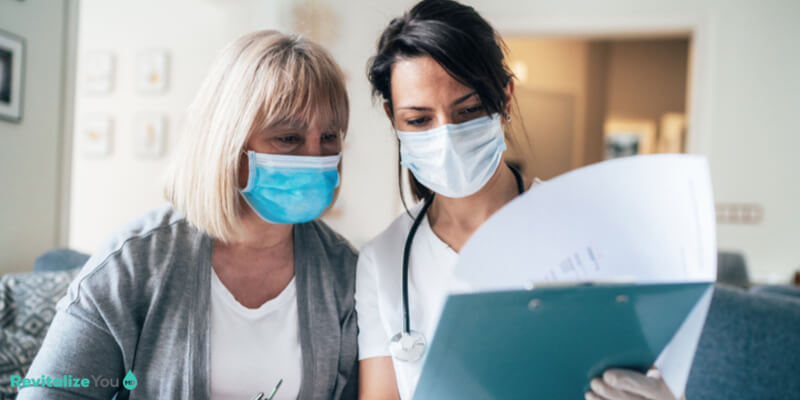
Menopause is one of the most challenging periods in a woman’s life. During this time, a woman’s estrogen levels fall, which produces dramatic physical changes in her body. These changes include hot flashes and vaginal dryness. Hormone Replacement Therapy (HRT) is meant to ease these menopause symptoms as the most effective treatment for menopausal changes. Although concerns have been raised about its safety, it still remains as the most effective solution for the relief of menopausal symptoms and prevention of osteoporosis.
Given this fact, is HRT the right course of treatment for you? For some women, the benefits will definitely outweigh the risks. For you to know if you’re among such women, a lot of factors need to be considered, including your age, genetics, and when you plan to start the treatment.
Scientist Edward Adelbert Doisy discovered the various forms of estrogen in the body in 1929. He and his colleagues created analytical techniques for measuring substances in the urine and blood. Later on, Doisy managed to isolate the female sex hormone, estrogen when he was analyzing the urine and follicular fluids of pigs.
It was also discovered that there are three types of estrogen that become more dominant in different stages of a woman’s life. Estradiol is the one during a woman’s first menstruation and menopause, estriol during her pregnancy, and estrogen after menopause.
Of course, it was only a matter of time that scientists will eventually figure out how to turn estrogen into a drug. Emmenin became the first commercial preparation of estrogen, an alcohol-soluble substance made from the extracts of human placentas. It became valuable for treating menstrual cramps, which is also known as dysmenorrhea.
Later on, scientists discovered that they can manufacture estrogen by collecting substances from the urine of pregnant mares, instead of deriving it from a placenta. The drug was named Premarin and was approved by the Food and Drug Administration (FDA) in 1942 for treating menopausal hot flushes.
Menopause, which means “the last period, is the stage in a woman’s life in which her menstruation ends. This happens when she stops ovulating (when her reproductive system releases a mature egg once a month) and her ovaries are no longer producing oestrogen, one of the female sex hormones.
It happens naturally to all women and marks the end of their reproductive years, which is the opposite of the first menstrual period during puberty, which is the start of the reproductive years. The average age when menopause happens is around 51 years, but it can happen way earlier. A woman can experience premature menopause, which happens when her final menstrual period happens before she turns 40. Early menopause is when her final period happens before she turns 45.
The majority of women experience uncomfortable symptoms before and after menopause hits them. These symptoms include hot flushes, night sweats, vaginal dryness, and sleep disturbance. These physical changes can be managed in different ways - eating healthier, exercising more, and taking HRT.

There comes a time that a woman’s body cannot make enough estrogen, for various reasons. The most common is aging, as estrogen production naturally slows down as one gets older. This results in hormonal imbalance.
Estrogen is the hormone that thickens the lining of the uterus and prepares it for the possible implantation of a fertilized egg. The hormone also influences how the body uses calcium, which is an essential mineral in bone health. Estrogen also helps in keeping healthy cholesterol levels in the blood and also essential in keeping the vagina healthy.
Progesterone is taken along with estrogen by women who still have their uterus. When estrogen is taken without progesterone, it increases a woman’s risk for endometrial cancer, which affects the lining of the uterus. During a woman’s reproductive years, the cells from her endometrium are shed when she menstruates. When menopause sets in and she no longer menstruates, she can no longer shed those cells from the endometrium. If she’s taking estrogen without progesterone, the former can cause an overgrowth of cells in the uterus, which makes her more susceptible to cancer.
This is why taking progesterone is important. It reduces the risk of having uterine cancer because it makes the endometrium thin. A woman who is taking progesterone can experience monthly bleeding or no bleeding at all. This will depend on the manner the hormone is taken. Taking progesterone and estrogen continuously can lessen the monthly bleeding or even eliminate it.
Women who do not have their uterus anymore because of hysterectomy typically have no need for progesterone. For them, taking estrogen alone is safer and has fewer long-term risks than taking the combined estrogen and progesterone.
HRT is prescribed to replace the body’s estrogen levels and ease discomfort. Here are the conditions that can be treated with HRT:
A woman’s body creates more estrogen at the onset of puberty. She will continue to produce higher levels of the hormone through her childbearing years. These levels will slowly start to drop as menopause approaches. When this happens, the body will start to encounter menopausal symptoms such as hot flushes, vaginal dryness, chills, insomnia, and excessive sweating. Taking HRT will help the menopausal woman deal with these conditions.
The ovaries, which are responsible for producing estrogen, may fail to produce them the way they should. This may spur the need to take HRT. Issues in the ovary that may need supplemental estrogen include female hypogonadism, or decreased function of the ovaries, failure of both ovaries, or removal of both ovaries, or an oophorectomy.
HRT can also help ease symptoms of premature menopause, which happens when ovaries are removed. At times, both the ovaries and the uterus are removed through a procedure called hysterectomy.
Taking HRT is also beneficial to vaginal health. When the body’s estrogen levels decline, the vagina goes through changes in its tissue, lining, and PH balance, resulting in the onset of symptoms that cause vaginal discomfort. These symptoms include dryness, vulvar atrophy (a condition that causes dryness, soreness, and urinary incontinence), and atrophic vaginitis, which is the inflammation of vaginal tissues that are frequently caused by dryness and irritation.
Bone health declines after menopause and estrogen can help protect the bones when it happens. However, there are medications available that do this job so a woman doesn’t have to rely on HRT to ward off osteoporosis. Just like other medications, they each have their own sets of possible side effects, so the doctor will weigh things and decide if these medications or HRT is the better choice.
There are two basic types of Hormone Replacement Therapy - Estrogen Therapy (ET) and Estrogen/Progesterone/Progestin Hormone Therapy (EPT). They focus on replacing the estrogen that the body cannot make anymore after menopause.
This is given to women who do not have their uterus anymore because of hysterectomy (the surgery to remove the uterus) or bilateral oophorectomy (surgical removal of the uterus and ovaries).
Giving low doses of estrogen is involved here and given in various forms, including the daily pill, patch, gel, spray, or vaginal ring. Here are the estrogen forms in detail:
Also called combination therapy as it combines doses of estrogen and the synthetic form of progesterone called progestin. This therapy is given to women who still have their uterus. Taking combined hormone therapy lowers a woman’s risk for endometrial cancer. Progesterone is generally used as a form of birth control, but it can also treat lots of menopausal symptoms.
The doctor will determine the best dosing schedule for the menopausal hormone therapy, who should have an appointment every three to six months during treatment to discuss the effects and make changes or stop if necessary. The FDA recommends that women who are taking HRT for menopausal symptoms should use the lowest dose possible for the shortest time needed.
Taking the HRT in pill form comes in two general schedules - cyclic or continuous.
The doctor will not advise menopausal hormone replacement therapy for women who have the following health conditions:
These risks vary depending on several factors: age, type of hormone therapy taken, and health history.

Just like other types of therapy, there are people who will benefit greatly from HRT in which the benefits will greatly outweigh the risks involved. Being in good general health is a given, but a woman will benefit most from HRT if she has the following characteristics:
HRT is a blessing when it comes to helping women get through menopause as comfortable as possible, but one has to take note of the risks involved. The doctor will always be forthright when it comes to the health risks that one may experience when taking HRT.
The risk of cardiovascular disease may be related more to the advanced age of a patient as opposed to HRT, according to an analysis of the World Health Initiative. They also discovered that when HRT is given to younger women, specifically at the onset of their menopause, the risks of heart disease appear to be lower.
The risk of heart disease increases in women taking long-term estrogen-progestin combination therapy (EPT) in their mid-60s or 10 years after their menopause. There seems to be no increase among women who started their HRT earlier than that (during their 50s and within 10 years of menopause). Analysis suggests that taking HRT during the earlier stage of menopause can actually lower the risk of heart disease.
This is not recommending the use of HRT solely for the purpose of preventing heart disease. However, the studies shed a better light on the risks and benefits of taking HRT in terms of being susceptible to heart disease.
Diagnosis of breast cancer gets higher when combination EPT is used for more than three to five years. It means that out of 10,000 women who use EPT for more than five years, there will be eight additional diagnoses of breast cancer.
In contrast, women who use just ET show no increase in developing cancer even after 11 years of use. When a woman stops HRT, her potential risk for breast cancer reverts to the baseline norm. This is why HRT can be used safely by women in their 50s, who are generally at lower risk for this cancer than older women.
As for breast cancer survivors, it’s advisable for them to avoid HRT unless other treatments are not effective. It can be considered also if a woman’s menopausal symptoms are making her quality of life suffer. In this case, careful consideration in consultation with a breast surgeon or oncologist is needed.
There’s no concrete evidence showing HRT increasing the risk of breast cancer recurring. But oestrogen and progestogens may stimulate some types of cells in the breast. Also, some types of HRT use have been linked to an increase in breast cancer risk in women who have a history of the disease.
Using oestrogen-only HRT increases the risk of endometrial cancer. Meanwhile, it's not seen with those taking combined continuous oestrogen and progestogen. The increased risk of ovarian cancer in relation to taking HRT is very small. It's estimated to be just one extra case per 10,000 HRT users per year. A recent review linked HRT to two types of tumors - serous and endometrioid cancers.
Venous Thrombosis is the condition in which blood clots form inside the body’s veins. Women under the age of 50 and those aged 50 to 60 are more at risk of developing venous thrombosis if they are taking HRT orally.
The increased risk looks to be more likely in the first year or two of HRT and also in women who are at higher risk of developing blood clots. Women who are genetically predisposed to developing thrombosis are discouraged to undergo HRT.
Some studies point to combined oestrogen and progestogen in oral (tablet) form in relation to the increased risk of clots. It also depends on the type of progestogen used. Some research suggests that taking non-oral HRT (via patches, gels, and implants) has a lower risk in comparison.
Cholecystitis happens when gallstones in the gallbladder block ducts, causing infection and inflammation. Using oral HRT presents a slightly higher risk of developing cholecystitis while using patch treatment shows lower risk figures. Surgical removal of the gallbladder is needed to treat cholecystitis.
Weight gain is one of the common effects of menopause, but it also depends on lifestyle factors. The hormonal changes that happen in a woman’s body due to menopause result in a possible increase in body fat, most especially around the abdomen. Other factors that contribute to weight gain are an age-related decrease in muscle tissue and a decrease in exercise levels.
There is no concrete link between weight gain and HRT use. A woman will put on weight if she’s prone to gaining during her middle years regardless if she’s on HRT or not.
There are ways to reduce the health risks associated with taking HRT. These are:

The doctor will take in medical history and all other factors into consideration in helping a woman decide which product and method are right for her. A patient can choose to take estrogen via pill, patch, gel, vaginal ring, or vaginal cream. Estrogen in low-dose vaginal creams, tablets, or rings is usually prescribed for those who experience only vaginal symptoms related to menopause. This is usually the better option compared to oral pills or skin patches.
Doctors will usually go for prescribing the lowest effective dose for the shortest amount needed for treating menopausal symptoms. Those who are below 45 years old need enough estrogen to protect them against the long-term health effects of estrogen deficiency. A longer treatment may be needed for those with lasting symptoms that can significantly impair their quality of life.
This is just another reason to make the leap to a healthier lifestyle. It’s always a good idea to maintain regular exercise, a balanced diet, quit or never take up smoking, keep stress to a minimum, and manage chronic health conditions.
Visit your doctor regularly as you go through HRT. This will ensure that the benefits of your therapy will outweigh the risks. Have regular screenings such as mammograms and pelvic exams if needed.
The current belief is that overall, long-term use of HRT, meaning more than five years, has risks that far outweigh the benefits. The treatment should not be recommended for disease prevention, save for women under 60 years old who have a substantial risk of bone fractures. There is no alternative therapy yet that is clinically proven to reduce the risk of osteoporosis in menopausal women. Suggested therapies include using soy products, herbal medicines, and phytoestrogens (plant estrogens).
Special consideration is needed for prescribing HRT to women with hypertension (high blood pressure), migraine headaches, epilepsy, diabetes, gallbladder disease, liver disease, fibroids, and endometriosis. In case the treatment is approved, it should be given through the skin (transdermally) rather than orally.
Despite the risks involved in using HRT long-term, it may be the only effective therapy for women with severe and persistent menopausal symptoms. Also, women with premature or early menopause are still given the green light to take HRT long-term because of their higher chances of developing heart disease, osteoporosis, and some neurological conditions earlier. This is in comparison to women who are experiencing menopause at the usual age. Regular check-ups and specialist advice from a menopause clinic or menopause specialist are needed.
Balancing the risks versus the benefits and its outcome will vary for each woman. Factors such as age, personal medical history, and family medical history are taken into consideration. This is why it’s important to spend generous time with the doctor when it comes to discussing the benefits and risks of hormone therapy.
Women should evaluate their treatment plan each year when it comes to deciding how long they should take HRT. The therapy should be discontinued if a patient develops a medical condition that would put her health at great risk. But one should not stop the treatment abruptly without consulting the doctor.
HRT should be stopped when a patient develops heart disease or started with the primary purpose of avoiding heart disease. When this happens, other methods of prevention should be discussed, such as taking drugs to lower cholesterol and blood pressure, plus making major lifestyle changes.
Osteoporosis is an important issue as well in taking HRT as well. Treatment should not be taken just to prevent bone loss. The doctor should help weigh the risks and benefits in accordance with the patient’s condition. If taking HRT is not a good solution, alternate treatments for osteoporosis should be discussed.
If the doctor advises against giving HRT for any reason, a patient has no choice but to find other ways to ease menopausal symptoms. The hot flushes can be managed by keeping cool all the time and limiting the intake of caffeine and alcoholic beverages.
The patient will also benefit from practicing breathing techniques. The doctor can prescribe non-hormone prescription medications that can help deal with hot flushes better.
For vaginal symptoms, lubricants are the best way to deal with dryness or painful intercourse. Ask the doctor for ospemifene, which can help relieve the episodes of pain during intercourse.
Other treatments for menopausal symptoms include black cohosh, which is an herbal medicine that can take the edge off hot flushes and sweats. However, there is no data that supports its long-term use. Black cohosh can also be associated with a rare liver condition.
Normal fluctuations of hormones will happen to the body eventually and there’s nothing that can be done to stop it completely. But a woman can still make things better for her body by managing estrogen levels apart from taking HRT. These essential lifestyle changes can prevent some of the complications of estrogen loss:
There are women who would benefit greatly from taking HRT compared to others. Women who have a personal or family medical history that is deemed safer from the risks that the treatment may bring should go ahead and do it, with the approval and guidance of a doctor. Recommendations may change as the medical community learns more about HRT and other menopausal treatments.
Let Revitalize You MD help you decide if hormone replacement therapy is the best for your menopausal symptoms. Our high standard of treatment, overall safety record, and professionalism of our medical team has helped build our reputation not just in hormone therapies but other medical procedures as well. Call us today and discuss your options for menopausal symptom relief.
The staff is great, the products work!! I am very pleased with my results!